Abocom Systems WUE1K5 Ethernet USB Adapter User Manual WUE1500MNL
Abocom Systems Inc Ethernet USB Adapter WUE1500MNL
Revised Users Guide
Doc. No.: 071202-01
802.11b
Wireless & Fast
Ethernet
USB Adapter
User Guide
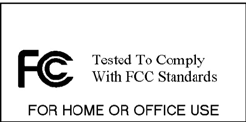
REGULATORY STATEMENTS
FCC Certification
The United States Federal Communication Commission (FCC) and the Canadian
Department of Communications have established certain rules governing the use
of electronic equipment.
Part15, Class B
This model 802.11b Wireless & Fast Ethernet USB Adapter (WUE1500) must be
installed and used in strict accordance with the manufacturer’s instructions as
described in the user documentation that comes with the product.
This device complies with Part 15 of FCC rules. Operation is subject to the
following two conditions:
1) This device may not cause harmful interface, and
2) This device must accept any interface received, including interface that may
cause undesired operation. This equipment has been tested and found to
comply with the limits for a Class B digital device, pursuant to Part 15 of the
FCC Rules. These limits are designed to provide reasonable protection against
harmful interference in a residential installation. This equipment generates,
uses and can radiate radio frequency energy, and if not installed and used in
accordance with the instructions, may cause harmful interference to radio
communications. However, there is no guarantee that interference will not
occur in a particular installation. If this equipment does cause harmful
interference to radio or television reception, which can be determined by
turning off and on, the user is encouraged to try to correct the interference by
one or more of the following measures:
◗ Reorient or relocate the receiving antenna.
◗ Increase the distance between the equipment and receiver.
◗ Connect the equipment into an outlet on a circuit different from that to which
the receiver is connected.

Warring: Changes or modifications not expressly approved by party responsible for
compliance could void the user the user authority to operate the equipment
CAUTION:
1) To comply with FCC RF exposure compliance requirements, a separation
distance of at least 20 cm must be maintained between the antenna of this
device and all persons.
2) This transmitter must not be co-located or operating in conjunction with any
other antenna or transmitter.
Technical Support
AboCom Systems, Inc.
300 1F, No.21, R&D Rd.II, SBIP, Hsin-Chu, Taiwan , R.O.C.
Head office :
Tel: 886-3-5789090
Fax:886-3-5789520
Technical Support:
Tel: 0800-079-123
E-Mail: support@abocom.com.tw
Website: www.abocom.com.tw
U.S Service Center:
D-LINK CORPORATION
53 DISCOVERY DRIVE, IRVINE CA 92618, USA
TEL: 714-788-0805

Table of Contents
INTRODUCTION ..................................................................................1
FEATURES .............................................................................................2
SOFTWARE INSTALLATION............................................................3
INSTALLATION THE UTILITY UNDER WINDOWS 98SE/ME/2000 ...........3
HARDWARE INSTALLATION ..........................................................7
INSTALLATION OF THE USB ADAPTER FOR WINDOWS 98SE/ME/2000 7
Manually................................................................................... 7
Automatically ...........................................................................8
Under Windows 98SE ......................................................8
Under Windows ME ......................................................... 9
Under Windows 2000 .....................................................10
INSTALLATION OF THE USB ADAPTER FOR WINDOWS XP .................. 11
NETWORK CONNECTION ..............................................................16
CONFIGURING THE NETWORK PROTOCOLS FOR WINDOWS 98SE/ME.16
CONFIGURING THE NETWORK PROTOCOLS FOR WINDOWS 2000.........20
USB 10/100 Network Adapter................................................20
Wireless USB Adapter............................................................ 23
CONFIGURING THE NETWORK PROTOCOLS FOR WINDOWS XP............24
USB 10/100 Network Adapter................................................24
Wireless USB Adapter............................................................ 26
CONFIGURATION PROCEDURE ................................................... 27
CONFIGURATION AND MONITOR UTILITY FOR WINDOWS
98SE/ME/2000 ...................................................................................27
CONFIGURATION FOR WINDOWS XP ................................................... 39
USB 10/100 Network Adapter................................................39
Wireless USB Adapter............................................................ 41
UNINSTALL PROCEDURE............................................................... 47
UNINSTALL PROCEDURE UNDER WINDOWS 98SE/ME/2000 ..............47
Uninstall the Configuration Utility .........................................47
Uninstall the device ................................................................49
Under Windows 98SE/ME .............................................49
Under Windows 2000 .....................................................50
UNINSTALL PROCEDURE UNDER WINDOWS XP .................................. 53
Uninstall the driver .................................................................53
USB 10/100 Network Adapter........................................ 53
Wireless USB Adapter....................................................56
Uninstall the device ................................................................57
USB 10/100 Network Adapter........................................ 57
Wireless USB Adapter....................................................58
SPECIFICATIONS ..............................................................................60
Wireless.........................................................................60
LAN ...............................................................................61
- 1 -
Introduction
The 802.11b Wireless & Fast Ethernet USB Adapter is the
multifunction device for your wireless network applications and based on
the IEEE 802.11b standard offering a data rate of 11Mbps in a wireless
LAN environment and 10/100Mbps traditional network. It is a
high-speed wireless network device that plugs into your notebook or
desktop PC and accesses to the LAN or peer-to-peer networking easily
without wires or cables. Besides, this device allows you to connect the
traditional 10/100 Mbps network via the RJ-45 port. Whether you’re at
your desk or in the boardroom, it allows you to share printers, files, and
other network resources via wireless LAN or Fast Ethernet network.
The USB adapter designed to be inserted into a USB type A port of a
laptop or desktop computer creating a wireless or LAN workstation.
With the tightly integrated wireless LAN and LAN networking, the users
do not need to juggle multiple cards for concurrent use of wireless LAN
and LAN, it is greatly improvement of the wireless and LAN and gets the
real convenience.

- 2 -
Features
Complies with IEEE802.11b standard for 2.4GHz Wireless LAN
Dual-speed RJ-45 port auto-negotiation 10BaseT/100BaseTX
USB 1.1 compliant
USB Plug & Play
Interoperable with existing network infrastructure
Secure information transmission
Freedom to roam while staying connected
Compatible with specialty wireless products and services
Up to 11Mbps data rate
Support operating systems such as Window 98SE/2000/ME/XP
Lower power consumption
Easy of Installation
High-power Bus-power no external power is required
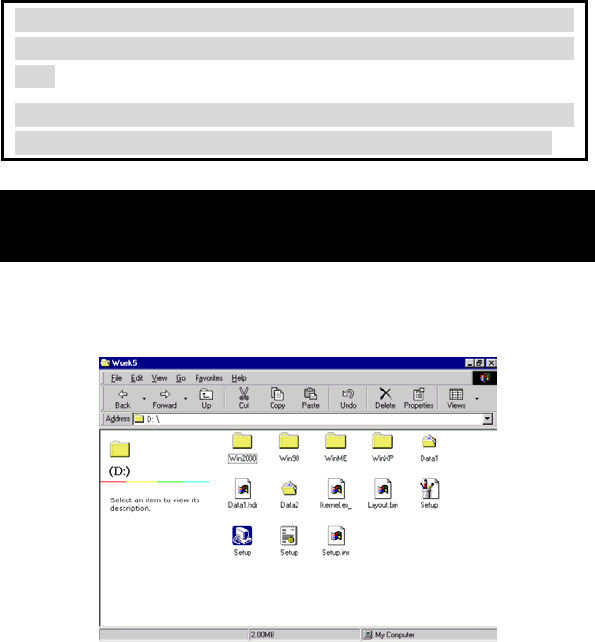
- 3 -
Software Installation
Precaution for Windows 98SE, 2000, and ME users: Please install
the Adapter's software before installing the hardware for saving your
time.
Precaution for Windows XP users: It’s not necessary to install the
utility, since the device will use the built-in utility in Windows XP.
Installation the Utility under Windows
98SE/ME/2000
1. Insert the Setup Utility CD-ROM into the CD-ROM drive and
double click on Setup.exe to install the Configuration & Monitor
Utility.
2. When the Welcome screen appears, click Next to continue.
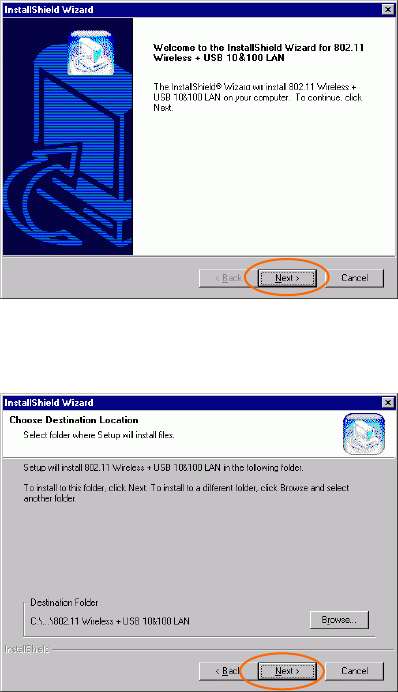
- 4 -
3. The Choose Destination Location screen will show you the default
destination chosen by the utility. Click Next to continue.
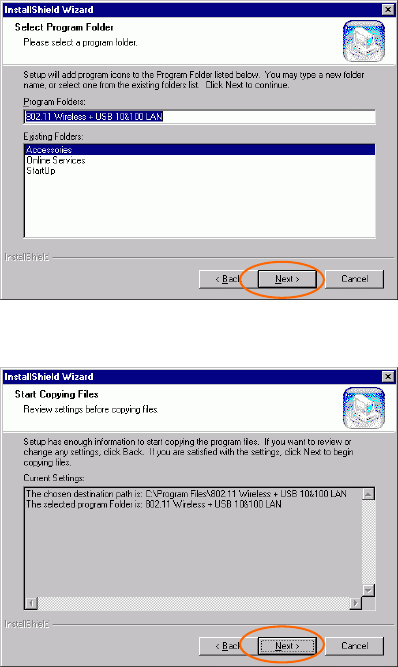
- 5 -
4. Follow the instruction to select the program folder. Click Next to
continue.
5. In Start Copying Files, click Next to continue.
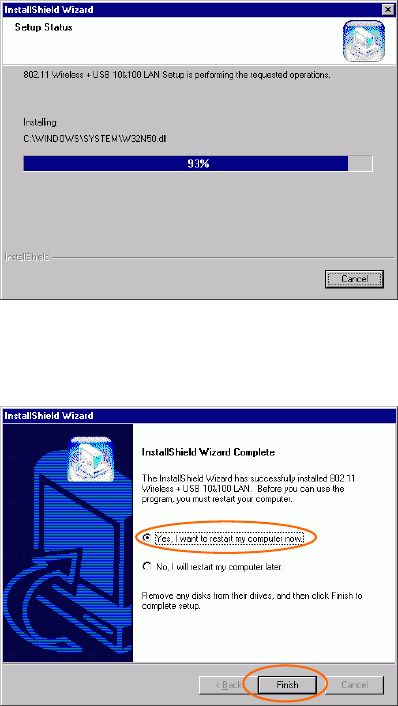
- 6 -
6. In Setup Status, the InstallShield Wizard will begin copying the
files.
7. After the Configuration Utility has been successfully installed, select
Yes, I want to restart my computer now, and then click Finish to
restart.

- 7 -
Hardware Installation
Installation of the USB Adapter for Windows
98SE/ME/2000
Automatically
Precaution for Windows 98SE, 2000, and ME users: If the
Application setup in Installation the Utility under
Windows98SE/ME/2000 has been completed, follow below steps to
install the hardware.
For Windows 98SE users: As you perform the installation, have
your system operating CD-ROM at hand. You may be asked to insert
the OS CD-ROM for the system to download a specific driver.
1. Plug the square end (Type B) of USB cable into the adapter's USB
port.
2. Plug the rectangle end (Type A) of USB cable into the PC's USB
port.
3. Insert one end of your network cable into the RJ-45 network port.
Connect the other end of the cable into a Hub.
After the device has been connected to your computer, Windows will
detect the new hardware and then automatically copy all of the files
needed for networking.
Precaution for Windows 2000 users: When Digital Signature Not
Found screen appears, click Yes to continue.
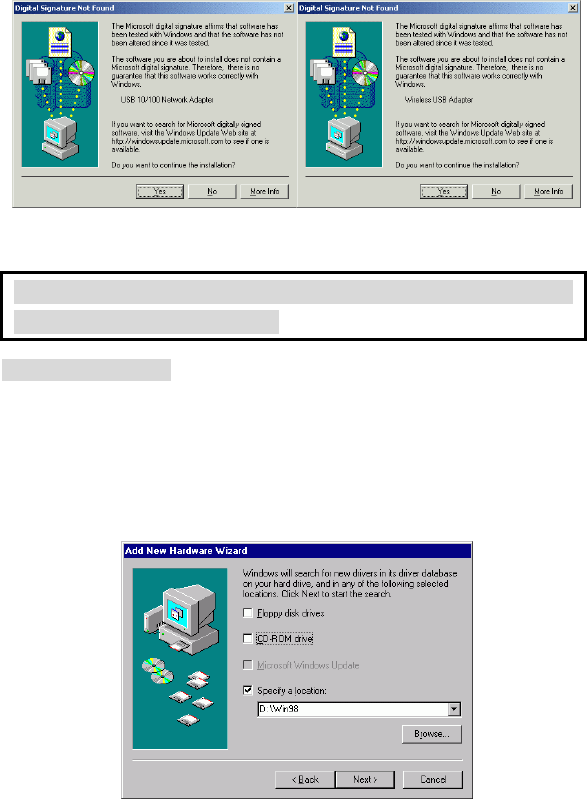
- 8 -
Manually
If you want to install the Hardware before installing the utility,
please follow the below section.
Under Windows 98SE
1. In Add New Hardware Wizard, click Next.
2. Click Search for the best driver for your device (Recommended).
3. Insert the device driver CD-ROM into the CD-ROM drive. Select
Specify a location: and click Browse to provide the appropriate
path (e.g. D:\Win98). Click Next.
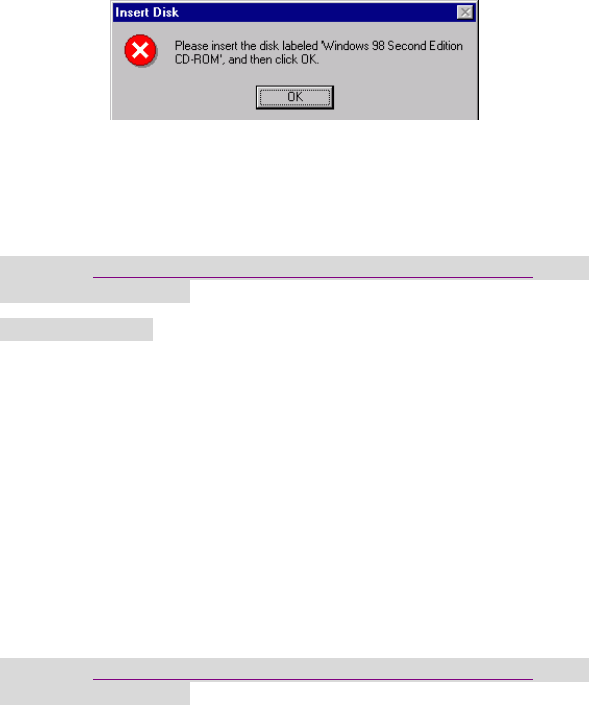
- 9 -
4. Click Next, Windows will copy all the necessary files to your
system.
5. Insert Windows 98SE CD-ROM.
6. Click Finish to continue.
7. When Windows prompts you to restart your computer, click No.
8. Repeat step 1-6.
9. When Windows prompts you to restart your computer, click Yes.
Then go to Installation the Utility under Windows98SE/ME/2000 section
for installing the utility.
Under Windows ME
1. Select Specify the location of the driver (Advanced), click Next.
2. Insert the device driver CD-ROM into the CD-ROM drive. Select
Search for the best driver for your device (Recommended) and
click Browse to provide the appropriate path (e.g. D:\WinME).
Click Next.
3. Click Next, Windows will copy all the necessary files to your
system.
4. Click Finish to continue.
5. When Windows prompts you to restart your computer, click No.
6. Repeat step 1-4.
7. When Windows prompts you to restart your computer, click Yes.
Then go to Installation the Utility under Windows98SE/ME/2000 section
for installing the utility.
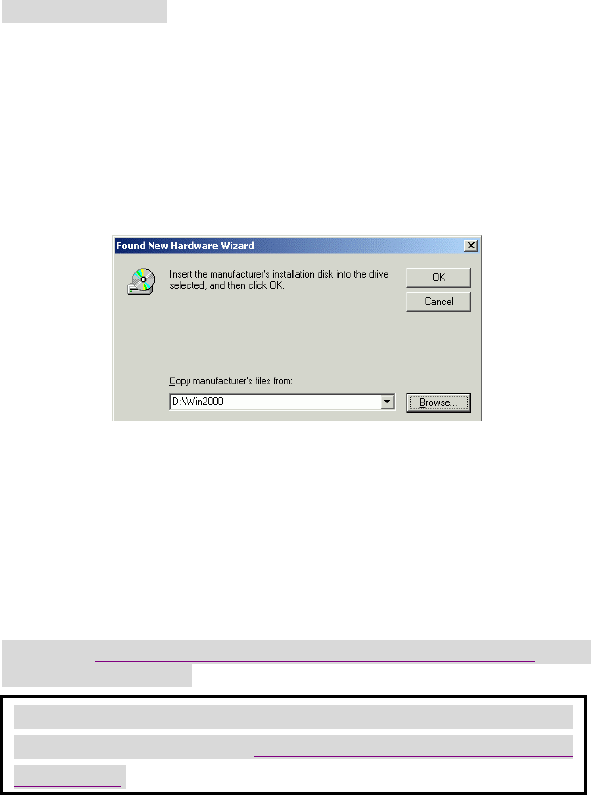
- 10 -
Under Windows 2000
1. In Found New Hardware Wizard, click Next.
2. In Install Hardware Device drivers, click Search for a suitable
driver for my device (Recommended).
3. Insert the device driver CD-ROM into the CD-ROM drive. Select
CD-ROM drivers and Specify a location.
4. Click Browse to provide the appropriate path (e.g. D:\Win2000).
Click OK.
5. Click Next, Windows will copy all the necessary files to your
system.
6. Click Yes to continue the installation.
7. Click Finish to continue.
8. Repeat step 1-6.
9. Click Finish.
10. Restart your computer.
Then go to Installation the Utility under Windows98SE/ME/2000 section
for installing the utility.
Precaution for Windows XP users: You must install the Adapter's
hardware, and then go to Installation of the USB Adapter for
Windows XP.
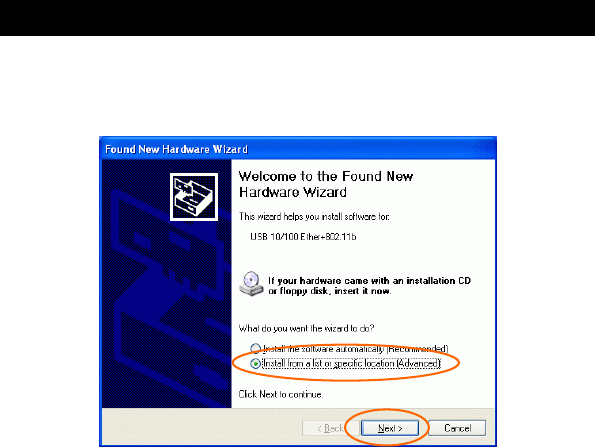
- 11 -
Installation of the USB Adapter for Windows XP
1. Once the device is well connected to your computer, Windows XP
will automatically detect the new device. Click Install from a list…
and click Next.
2. Insert the Setup Utility CD-ROM into the CD-ROM drive. Select
Include this location in the search: and click Browse to provide
the appropriate path (e.g. D:\WinXP). Click Next.
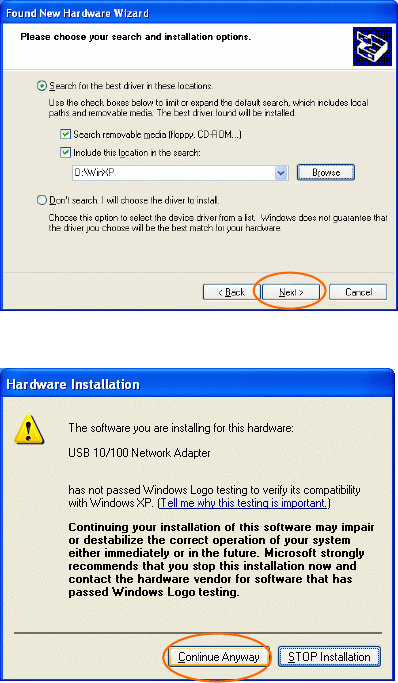
- 12 -
3. Click Continue Anyway to proceed.
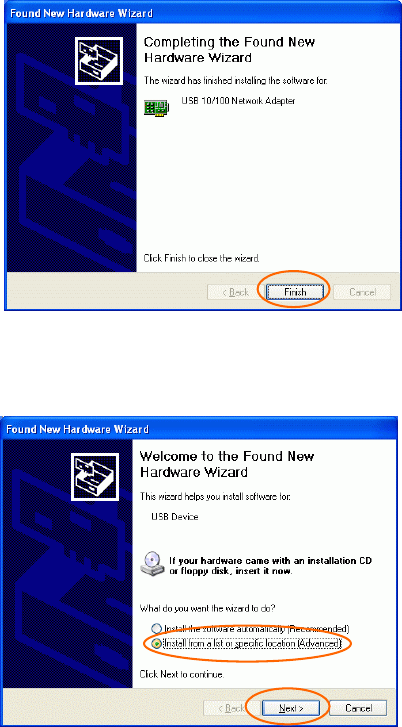
- 13 -
4. Click Finish to continue the Utility installation.
5. Wait for seconds. Windows XP will automatically detect the new
hardware. Click Install from a list or specific location (Advanced)
and click Next.
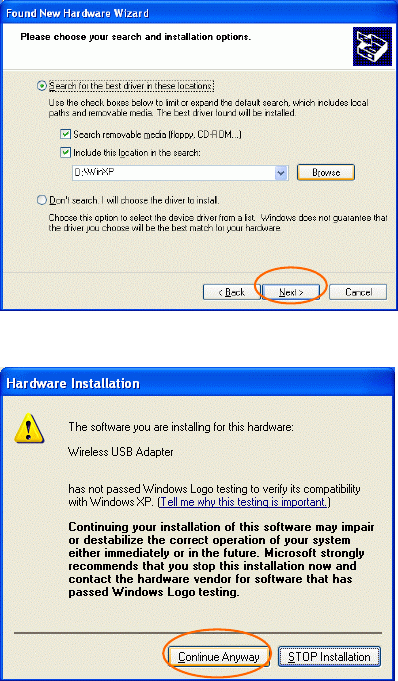
- 14 -
6. Select Include this location in the search: and click Browse to
provide the appropriate path (e.g. D:\WinXP). Click Next.
7. Click Continue Anyway to proceed.
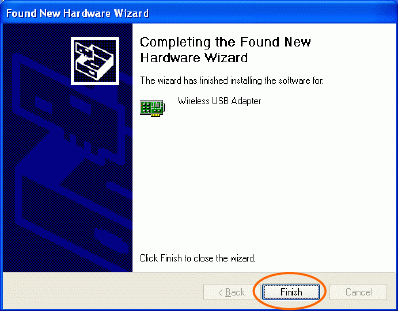
- 15 -
8. Click Finish to complete the Utility installation.
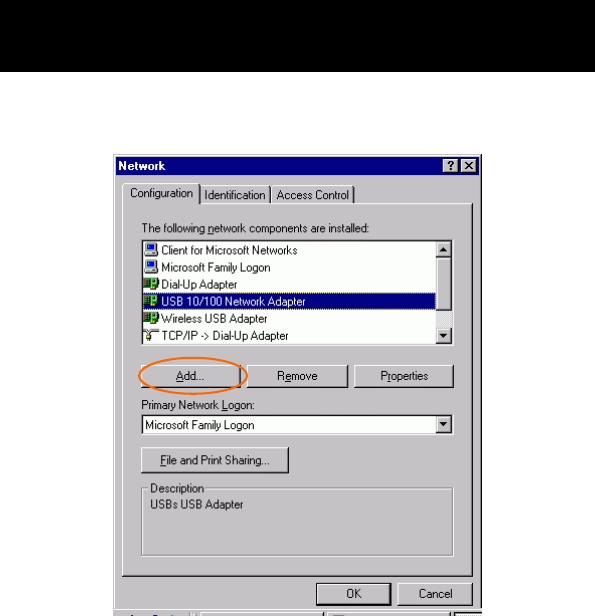
- 16 -
Network Connection
Once the driver has been installed, you must make some changes to your
network settings.
Configuring the Network Protocols for Windows
98SE/ME
1. Go to Start Settings Control Panel Network.
2. Make sure that you have all the following components installed.
USB 10/100 Network Adapter
Wireless USB Adapter
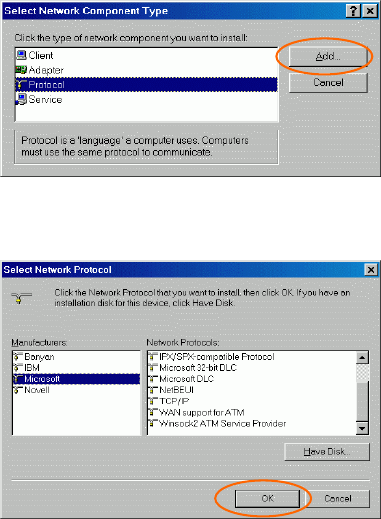
- 17 -
IPX/SPX-compatible Protocol
NetBEUI
TCP/IP
If any components are missing, click on the Add button to add them in.
All the protocols and clients required listed above are provided by
Microsoft.
3. After clicking Add, highlight the component you need, click Add.
4. Highlight Microsoft, and then double click on the item you want to
add. Click OK.
5. For making your computer visible on the network, enable the File
and Printer Sharing.
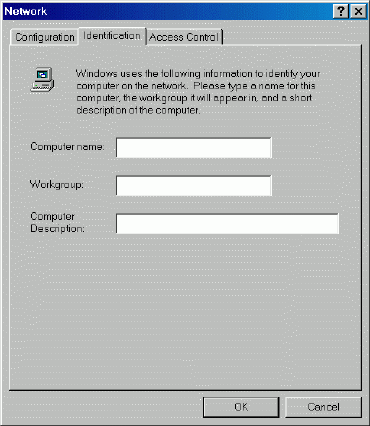
- 18 -
6. Click the Identification tab. Make up a name that is unique from
the other computers' names on the network. Type the name of your
workgroup, which should be the same used by all of the other PCs
on the network.
7. Click the Access Control tab. Make sure that “Shared-level
access control” is selected. If connecting to a Netware server,
share level can be set to “User-level access control.”
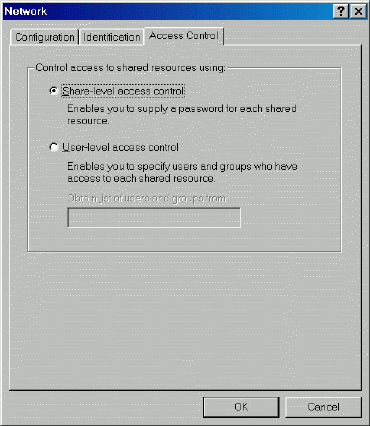
- 19 -
8. When finished, reboot your computer to activate the new device.
9. Once the computer has restarted and Windows has booted up, a
Logon window will appear and require you to enter a username and
password. Make up a username and password and click OK. Do
not click the Cancel button, or you won’t be able to log onto the
network.
10. Double-click the Network Neighbourhood icon on the Windows
desktop, and you should see the names of the other PCs on the
network.
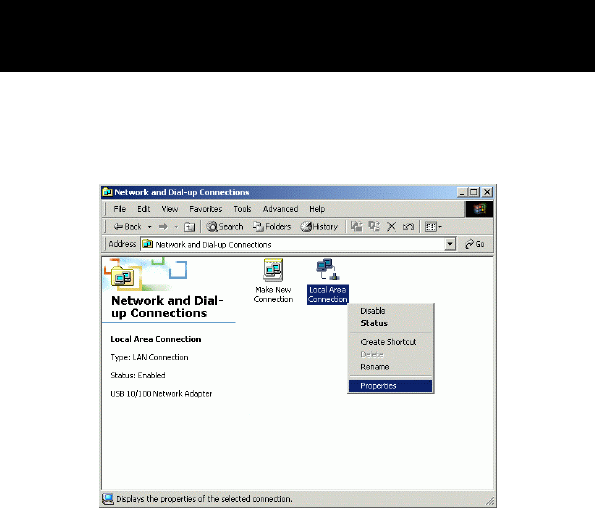
- 20 -
Configuring the Network Protocols for Windows
2000
USB 10/100 Network Adapter
1. Go to Start Settings Control Panel Network and Dial-up
Connections Local Area Connection Properties.
2. Make sure that you have all the following components installed.
Client for Microsoft Networks
NWLink NetBIOS
NWLink IPX/SPX/NetBIOS Compatible Transport Protocol
Internet Protocol (TCP/IP)
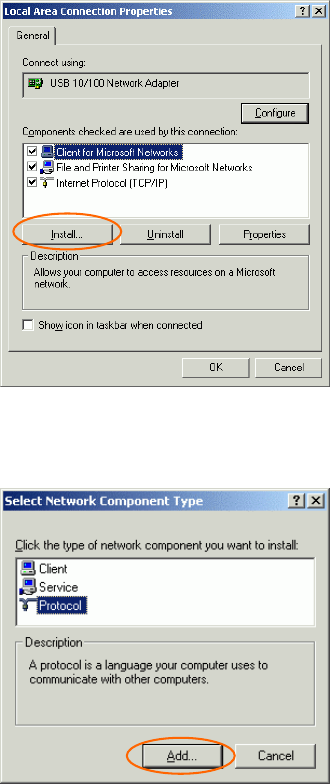
- 21 -
3. If any components are missing, click on the Install…button to select
the Client/Service/Protocol required. After selecting the component
you need, click Add…to add it in.
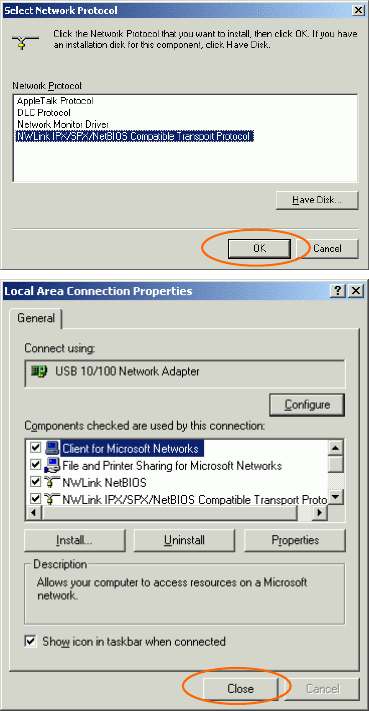
- 22 -
4. For making your computer visible on the network, make sure you
have installed File and Printer Sharing for Microsoft Networks.
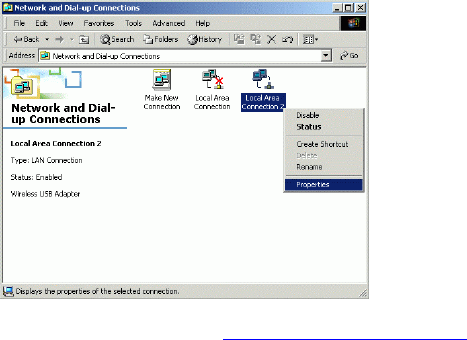
- 23 -
5. When finished, you must restart your computer to complete
installation.
Wireless USB Adapter
1. Go to Start Settings Control Panel Network and Dial-up
Connections Local Area Connection 2 Properties.
2. Repeat step 2-5 in previous section. (USB 10/100 Network Adapter)
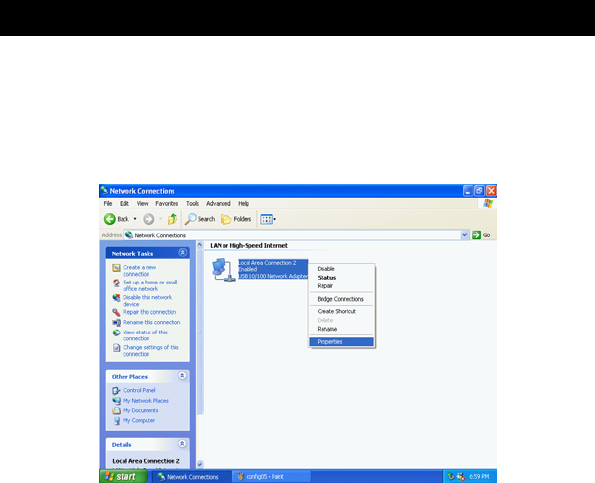
- 24 -
Configuring the Network Protocols for Windows XP
USB 10/100 Network Adapter
1. Go to Start Control Panel Network and Internet
Connections Network Connections Local Area Connection
Enabled USB 10/100 Network Adapter Properties.
2. Make sure that you have all the following components installed.
Client for Microsoft Networks
NWLink NetBIOS
NWLink IPX/SPX/NetBIOS Compatible Transport Protocol
Internet Protocol (TCP/IP)
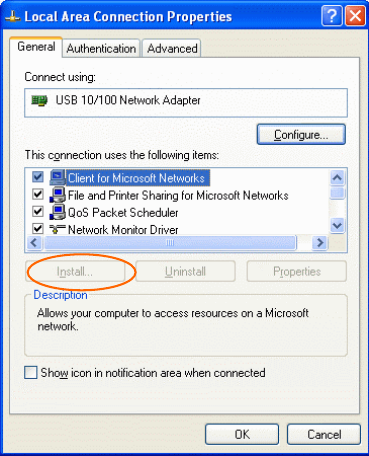
- 25 -
3. If any components are missing, click on the Install…button to select
the Client/Service/Protocol required. After selecting the component
you need, click Add…to add it in.
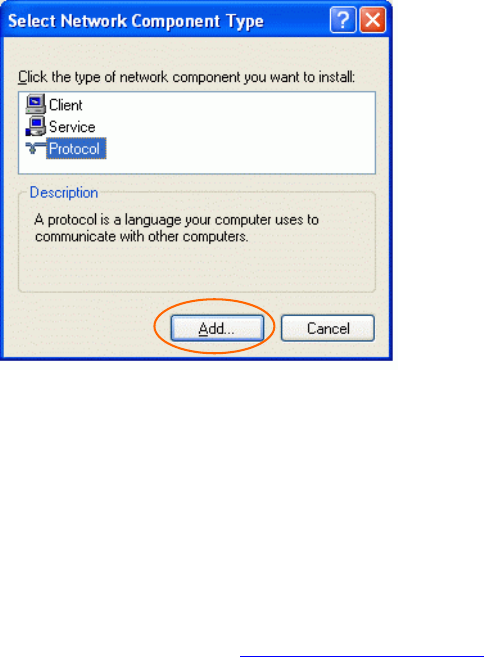
- 26 -
4. For making your computer visible on the network, make sure you
have installed File and Printer Sharing for Microsoft Networks.
5. When finished, you must restart your computer to complete
installation.
Wireless USB Adapter
1. Go to Start Control Panel Network and Internet
Connections Network Connections Local Area Connection
Enabled Wireless USB Adapter Properties
2. Repeat Step 2-5 in previous section. (USB 10/100 Network Adapter)
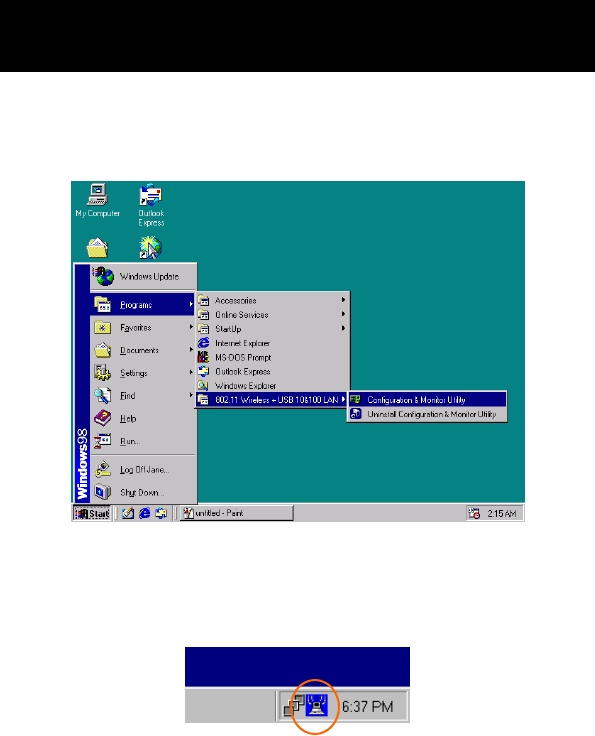
- 27 -
Configuration Procedure
Configuration and Monitor Utility for Windows
98SE/ME/2000
After installing the device successfully, go to Start Programs
802.11 Wireless + USB 10&100 LAN Configuration and Monitor
Utility.
The Wireless LAN Monitor Utility icon will appear in the taskbar every
time the device is running. You can open it by double-clicking on this
icon.
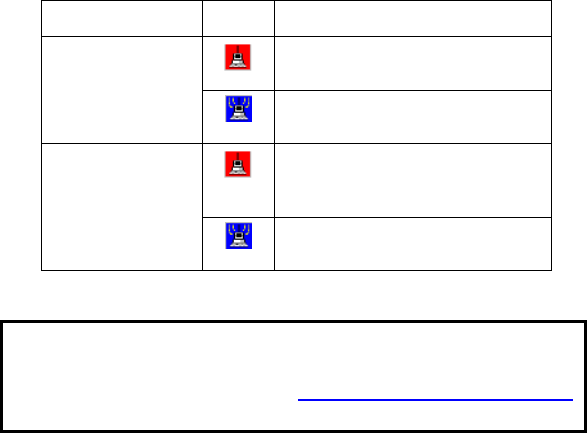
- 28 -
Icon Status
Mode Icon Link Status
Red. The station is not associated
to an Access Point.
Access Point mode
Blue. The station associates itself
to an Access Point.
Red. The color is red only when
the card is during resetting and
initialization procedure.
Peer-to-Peer mode
Blue. Peer-to-Peer mode is
activated.
Note: Except for the following configuration utility, using Windows
to configure the wireless network settings in the Windows XP is
recommended. (Please skip to the Configuration for Windows XP
section)
All settings are categorized into 6 tabs:
Status
Statistics
Site Survey
Encryption
Advanced
Info
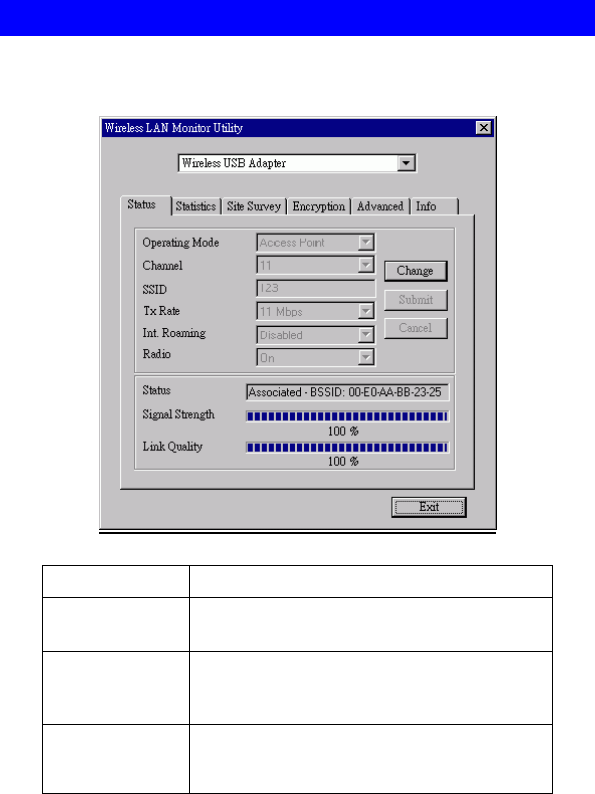
- 29 -
Status
The Status tab will display the current status of the Wireless USB
Adapter.
Item Description
Operating Mode It displays the current operating mode. (Access
Point or Peer-to -Peer).
Channel It shows the selected channel that is currently
used. (There are 14 channels available, depends
on the country.)
SSID The SSID is the unique name shared among all
points in your wireless network. The name must
b
e identical for all devices and
p
oints attem
p
tin
g

- 30 -
Item Description
to connect to the same network.
It shows the current SSID setting of the
Wireless USB Adapter.
Tx Rate It shows the current transfer rate. (1, 2, 5.5, or
11Mbps or Auto)
Int Roaming It displays the current roaming status. (Disabled
or Enabled)
Radio It displays the current status of the Wireless
USB Adapter. (On or Off)
Status It displays the information about the status of
the communication (the BSSID of the Access
Point to which the card is associated).
Signal Strength It displays the signal strength of the connection
between the Wireless USB Adapter and the
Access Point it connects.
Link Quality It displays the link quality of the connection
between the Wireless USB Adapter and the
Access Point it connects.
Change Click Change to change the configuration
parameters such as Operating Mode, SSID, Tx
Rate, and Int Roaming. (In Peer-to-Peer mode,
Change button is enabled).
Submit Click Submit to save the changes.
Cancel Click Cancel to ignore the previous setting.
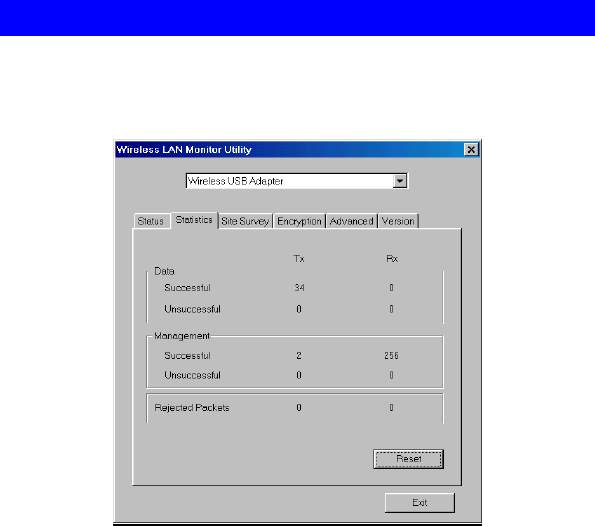
- 31 -
Statistics
This option shows you to view the available statistic information
(Data packets, Management Packets and Rejected packets). Press the
Reset button to renew or update this list of statistics.
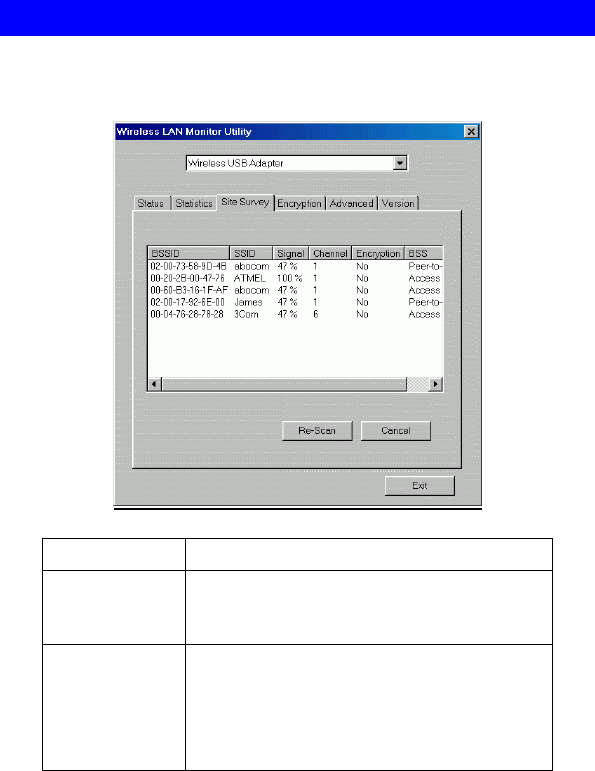
- 32 -
Site Survey
The Site Survey tab shows all the available Access Points and their
features.
Item Description
BSSID A set of wireless stations is referred to as a Basic
Service Set (BSS). Computers in a BSS must be
configured with the same BSS ID.
SSID The SSID is the unique name shared among all
points in your wireless network.
The name must be identical for all devices and
points attempting to connect to the same
network.

- 33 -
Item Description
Signal It displays the signal strength of the connection
between the Wireless USB Adapter and the
Access Point it connects.
Channel It shows the selected channel that is currently
used.
Encryption It displays the status of WEP Encryption.
BSS It displays the type of Basic Service Set.
Access Point: allows the Adapter to
communicate with a wired network which
employing an Access Point.
Peer-to-Peer: allows PC-to-PC,
station-to-station communication without
employing an Access Point.
Re-Scan Search for all available networks. Clicking on
the button, the device will start to rescan and list
all available sites.
Cancel Click Cancel to ignore the previous setting. (Do
not press Cancel while Re-Scan is working.)
Exit Click Exit to exit the application.
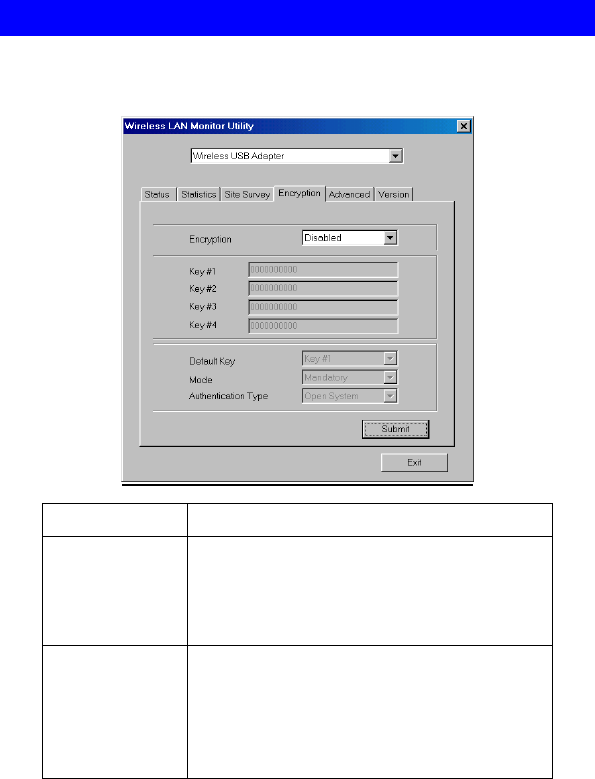
- 34 -
Encryption
WEP (Wired Equivalent Privacy) encryption can be used to ensure the
security of your wireless network.
Item Description
Encryption WEP is a data privacy mechanism based on a
64-bit/128-bit shared key algorithm.
Under the drop-down box, you can choose to
have WEP encryption Disabled, 64 Bit, or 128
Bit.
Key1/Key2/
Key3/Key4
This setting is the configuration key used in
accessing the wireless network via WEP
encryption. To generate an encryption key:
1. Select 64 Bit or 128 Bit.
2. Click "Key1" or "Key2" or "Key3" or "key4"
item, then fill in the appropriate value/phrase.

- 35 -
Default Key You can specify up to 4 different keys to decrypt
wireless data. Select the Default key setting from
the pull-down menu.
Mode Two WEP modes are available as below:
Mandatory and Optional.
Mandatory: WEP Encryption is required to
establish connection with other stations within
the wireless network.
Optional: Your station can communicate with
other stations within the wireless network
regardless if they use WEP or not.
Authentication
Type
The authentication type defines configuration
options for the sharing of wireless networks to
verify identity and access privileges of roaming
wireless network cards.
You may choose between Open System,
Shared Key, and Auto.
Open System: If the Access Point is using
"Open System" authentication, then the
wireless adapter will need to be set to the same
authentication type.
Shared Key: Shared Key is when both the
sender and the recipient share a secret key.
Auto: Select Auto for the USB adapter to select
the Authentication type automatically depending
on the Access Point Authentication type.
Submit Click Submit to save the changes.
Exit Click Exit to exit the application.
Note: You must use the same value/phrase or WEP key
settings for all wireless computers in order for the
wireless network to function well.
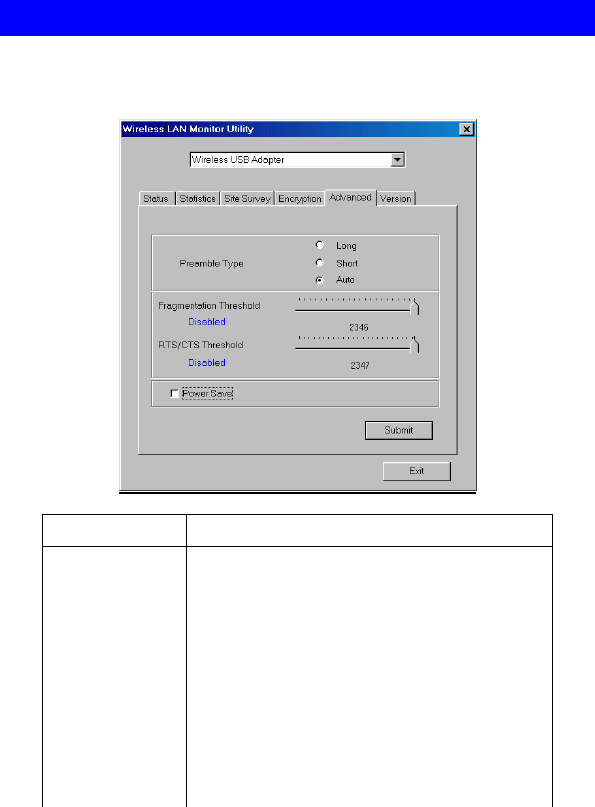
- 36 -
Advanced
You can change advanced configuration settings, such as the
Preamble Type, Fragmentation Threshold and RTS/CTS Threshold.
Item Description
Preamble Type A preamble is a signal used in wireless
environment to synchronize the transmitting
timing including Synchronization and Start
frame delimiter.
Long If in a "noisy" network environment, the
Preamble Type should be set to Long.
Short The Short preamble is intended for applications
where minimum overhead and maximum
performance is desired. If in a "noisy" network
environment, the performance would be
decreased.

- 37 -
Auto Select Auto for the USB adapter to select the
Preamble type automatically depending on the
Access Point Preamble type.
Fragmentation
Threshold
To fragment MSDU or MMPDU into small sizes
of frames for increasing the reliability of frame
(The maximum value of 2346 means no
fragmentation is needed) transmission. The
performance will be decreased as well, thus a
noisy environment is recommended.
RTS/CTS
Threshold
This value should remain at its default setting of
2347. Should you encounter inconsistent data
flow, only minor modifications of this value are
recommended.
Power Save Check the box to allow the Adapter to go to
sleep mode, during which data communication
could be interrupted.
Submit Click Submit to save the changes.
Exit Click Exit to exit the application.
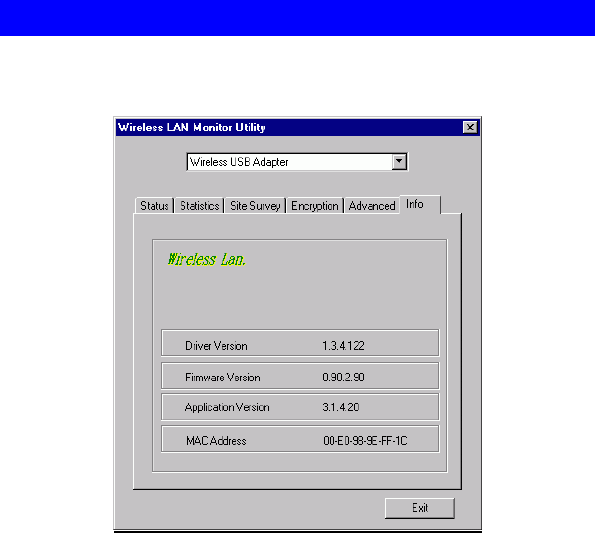
- 38 -
Info
You can view basic information about the Utility like the Driver, Firmware and
Application Version. Use the Exit button to exit the application.
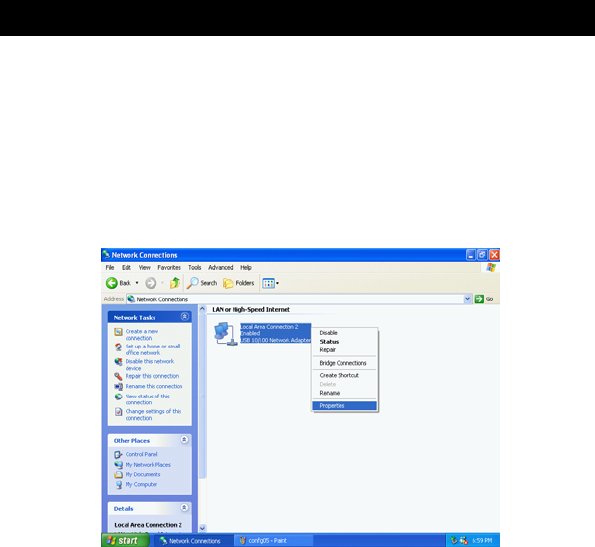
- 39 -
Configuration for Windows XP
USB 10/100 Network Adapter
1. Go to Start Control Panel Network and Internet
Connections Network Connections.
2. In Network Connections window, right-click the Local Area
Connection Enabled USB 10/100 Network Adapter icon, and
select Properties.
3. In Local Area Connection Properties window, select the General
tab. Click Configure to enable Windows configuration.
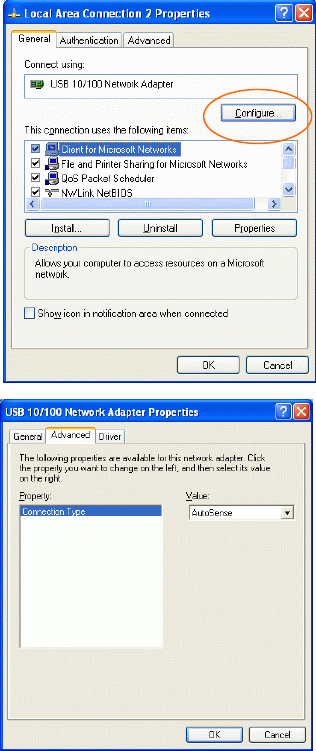
- 40 -
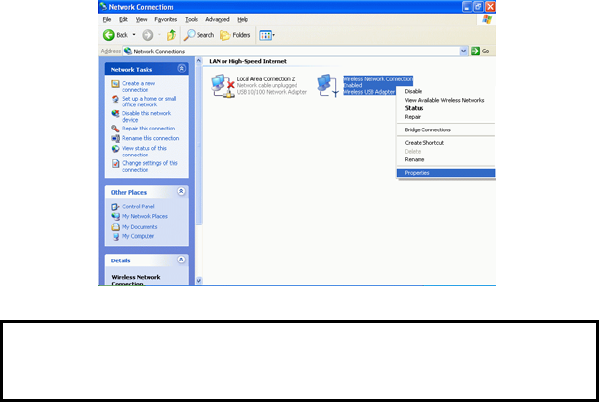
- 41 -
Wireless USB Adapter
1. Go to Start Control Panel Network and Internet
Connections Network Connections.
2. In Network Connections window, right-click the Wireless
Network Connection Enabled Wireless USB Adapter icon, and
select Properties.
Note: Double-click the Wireless Network Connection Enabled
Wireless USB Adapter icon and you will see the status of the wireless
PC Card.
3. In Wireless Network Connection Properties window, select the
Advanced tab.
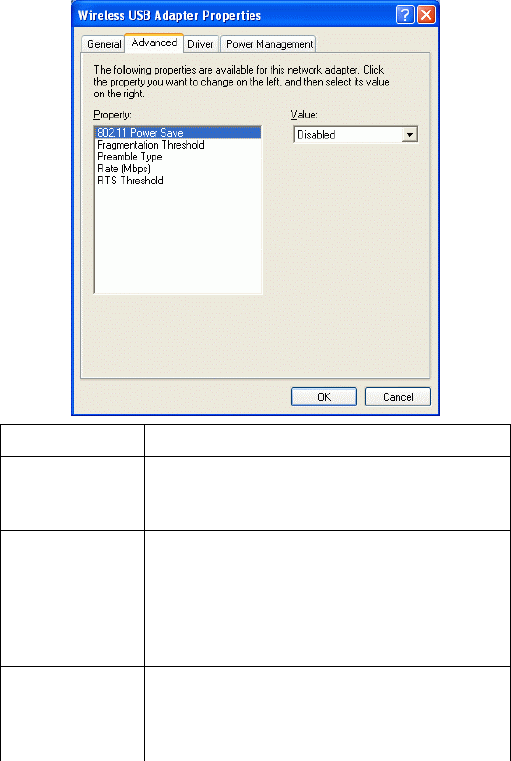
- 42 -
Property Description
802.11 Power
Save
Enable the function to allow the Adapter to go to
sleep mode, during which data communication
could be interrupted.
Fragmentation
Threshold
To fragment MSDU or MMPDU into small sizes
of frames for increasing the reliability of frame
(The maximum value of 2346 means no
fragmentation is needed) transmission. The
performance will be decreased as well, thus a
noisy environment is recommended.
Preamble Type A preamble is a signal used in wireless
environment to synchronize the transmitting
timing including Synchronization and Start
frame delimiter.

- 43 -
Long If in a "noisy" network environment, the
Preamble Type should be set to Long.
Short The Short preamble is intended for applications
where minimum overhead and maximum
performance is desired. If in a "noisy" network
environment, the performance would be
decreased.
Auto Select Auto for the USB adapter to select the
Preamble type automatically depending on the
Access Point Preamble type.
Rate (Mbps) It shows the current transfer rate. (1, 2, 5.5, or
11Mbps or Auto)
RTS Threshold This value should remain at its default setting of
2347. Should you encounter inconsistent data
flow, only minor modifications of this value are
recommended.
4. In Wireless Network Connection Properties window, select the
Wireless Networks tab.
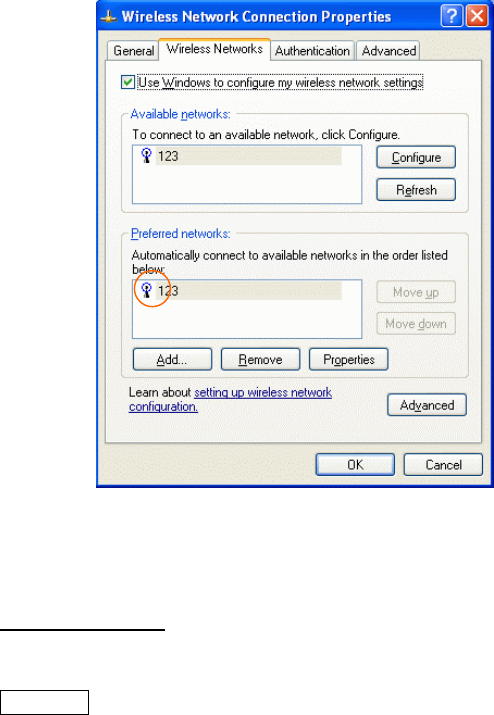
- 44 -
Use Windows to configure…
Check the box to enable Windows configuration.
Available networks
Displays all available networks.
Configure
Click the button to set up a new network or WEP configuration as
illustrated as below.
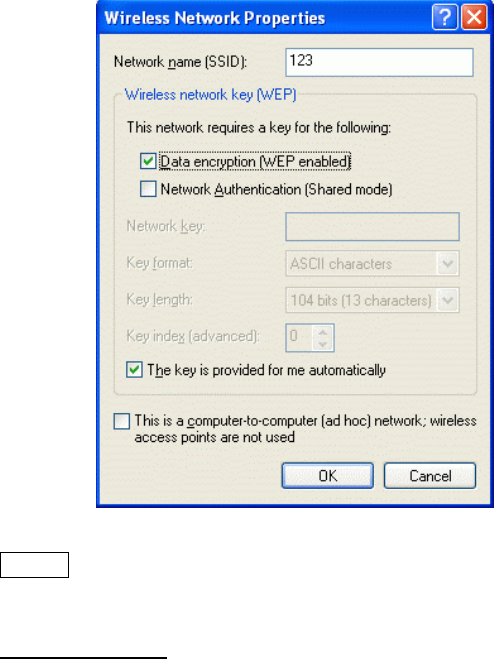
- 45 -
Refresh
Click the button to refresh and search for all available networks.
Preferred networks
From available network(s) listed above, you can select preferred one(s)
in an order that you can arrange.
The marked one is the currently used network.
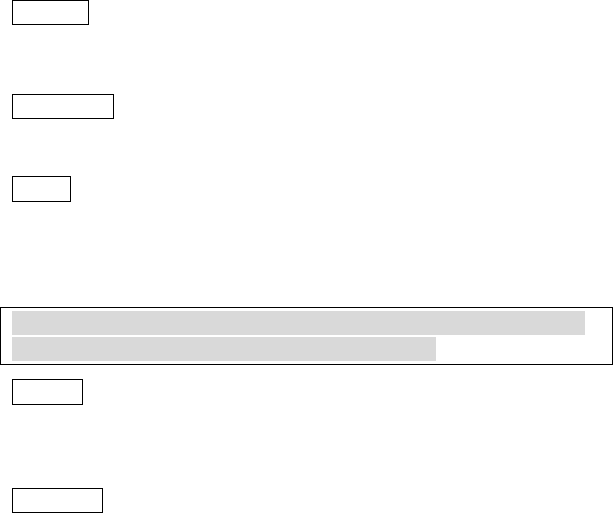
- 46 -
Move up
Move the selected network forward one position.
Move down
Move the selected network back one position
Add…
Click the button and the Wireless Network Properties window will
appear. In the Network name field, enter your desired network name
listed in the above Available networks box, and click OK.
Note: The new settings will be active only after you click on OK in the
Wireless Network Connection Properties window.
Remove
Highlight the unwanted network listed in the Preferred networks box,
and click the button to remove it.
Properties
Highlight the network listed in the above Preferred networks box, and
click the button to display its properties.
Once network configuration is done, make sure to click OK. The new
parameters will be saved and active only after doing so.
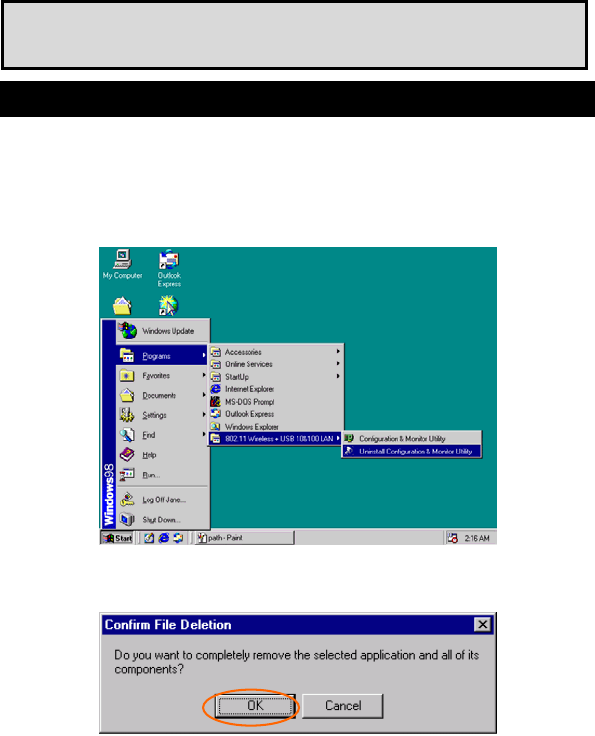
- 47 -
Uninstall Procedure
Note: In case you need to uninstall the Utility or device, please refer
to below section.
Uninstall Procedure Under Windows 98SE/ME/2000
Uninstall the Configuration Utility
1. Go to Start Programs 802.11 Wireless + USB 10&100 LAN
Uninstall Configuration and Monitor Utility.
2. Click OK to continue.
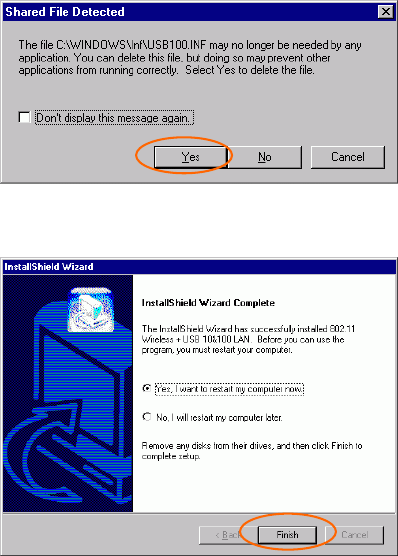
- 48 -
3. Click Yes.
4. Click Finish to complete the uninstalled procedure.
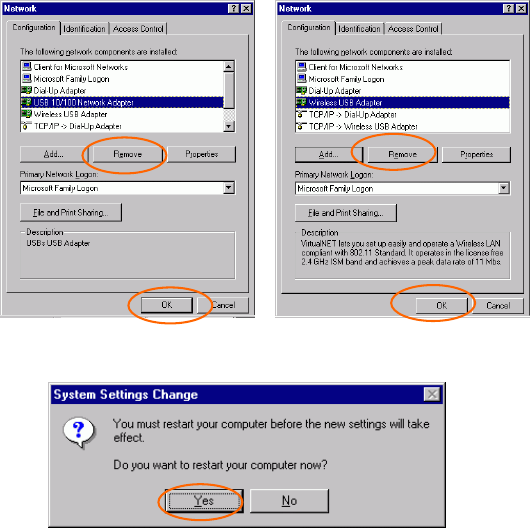
- 49 -
Uninstall the device
Under Windows 98SE/ME
1. Go to Start → Settings → Control Panel → Network.
2. Select USB 10/100 Network Adapter or Wireless USB Adapter
then click Remove. Click OK.
3. The system will prompt you to restart your computer. Click Yes.
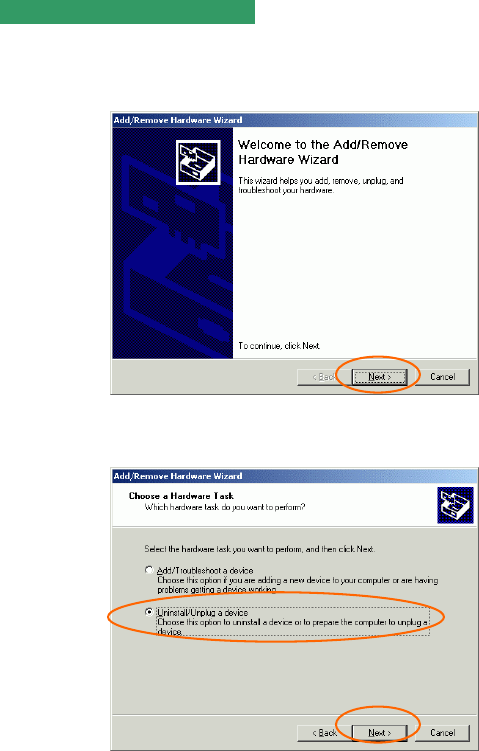
- 50 -
Under Windows 2000
USB 10/100 Network Adapter
1. Go to Start → Control Panel → Add/Remove Hardware.
2. When the Welcome screen appears, click Next to continue.
3. In Choose a Hardware Task, select Uninstall/Unplug a device and
click Next.
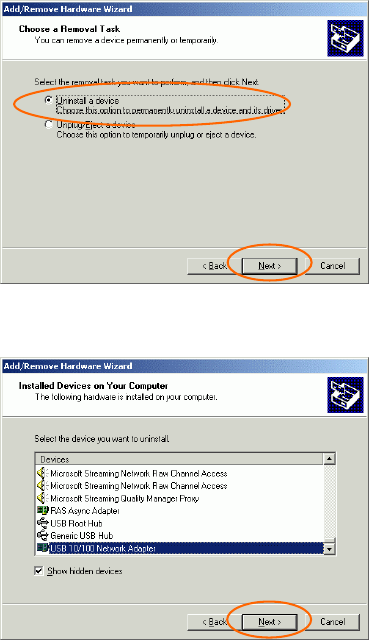
- 51 -
4. In Choose a Removal Task, select Uninstall a device and click
Next.
5. Check the Show hidden devices check box and locate the device in
the device list. Select the device and click Next.
6. Select Yes, I want to uninstall this device and click Next.
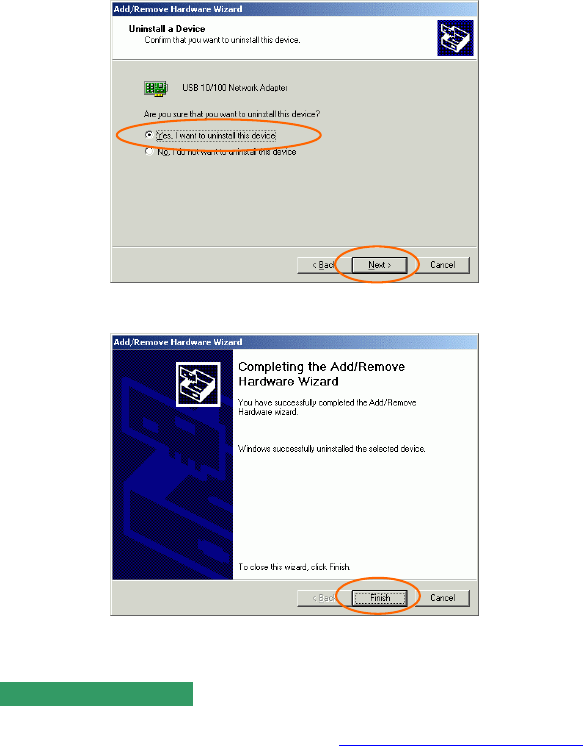
- 52 -
7. Click Finish to complete the uninstalled procedure.
Wireless USB Adapter
1. Repeat Step 1-4 in previous section. (USB 10/100 Network Adapter)
2. Check the Show hidden devices check box and locate the device in
the device list. Select the device and click Next.
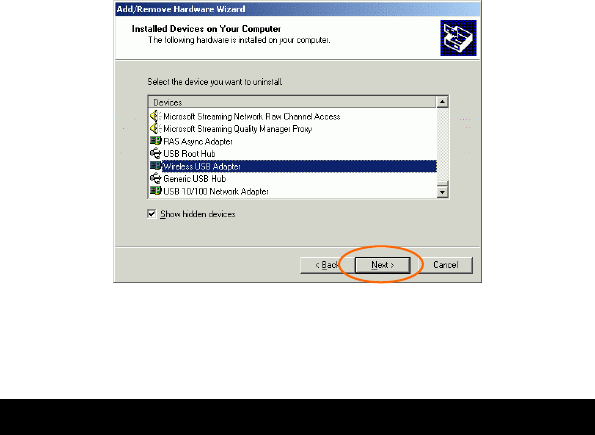
- 53 -
3. Select Yes, I want to uninstall this device and click Next.
4. Click Finish to complete the uninstalled procedure.
Uninstall Procedure Under Windows XP
Uninstall the driver
USB 10/100 Network Adapter
1. Go to Start Control Panel Network and Internet
Connections Network Connections Local Area Connection
Enabled USB 10/100 Network Adapter Properties.
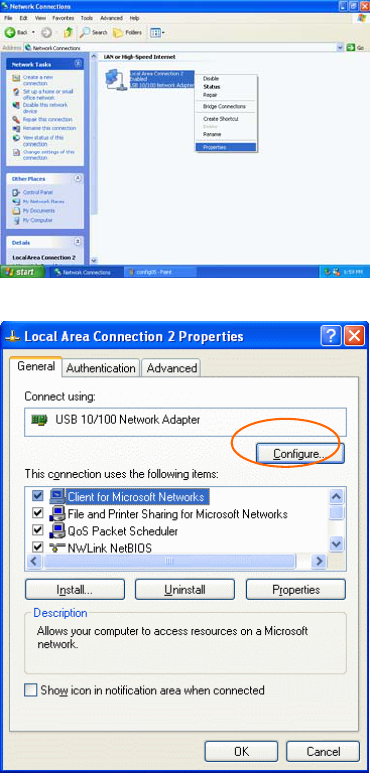
- 54 -
2. Click Configure to continue.
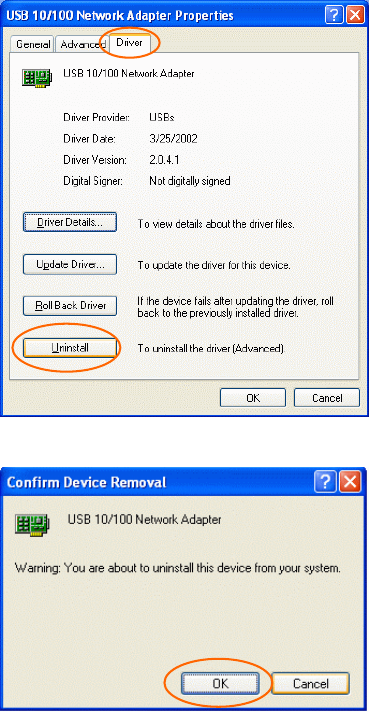
- 55 -
3. In Driver tab, click Uninstall to uninstall this device.
4. Click OK to complete the uninstalled procedure.
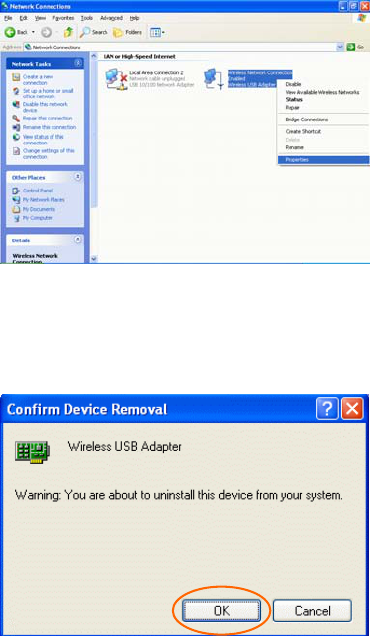
- 56 -
Wireless USB Adapter
1. Go to Start Control Panel Network and Internet
Connections Network Connections Wireless Network
Connection Enabled Wireless USB Adapter Properties.
2. Click Configure to continue.
3. In Driver tab, click Uninstall to uninstall this device.
4. Click OK.
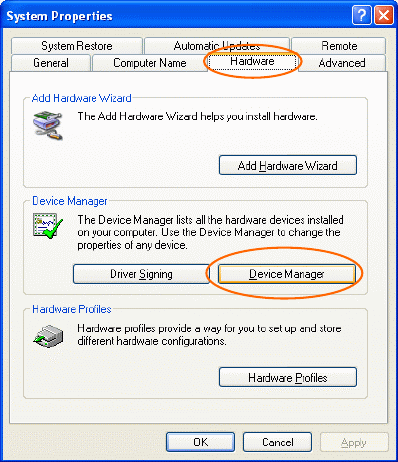
- 57 -
Uninstall the device
USB 10/100 Network Adapter
1. Go to Start Control Panel System Hardware Device
Manager.
2. In Network Adapter item, right-click USB 10/100 Network
Adapter and then select Uninstall.
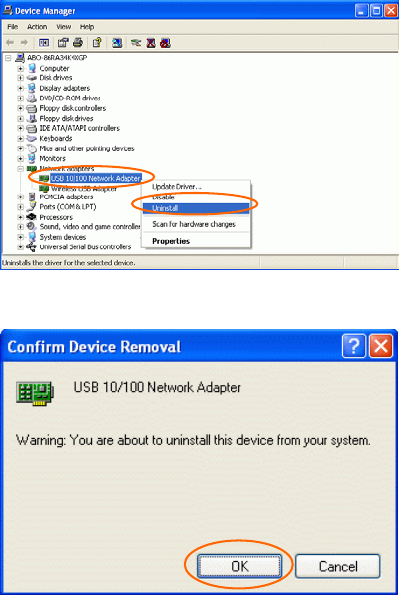
- 58 -
3. Click OK to uninstall this device.
Wireless USB Adapter
1. Go to Start Control Panel System Hardware Device
Manager.
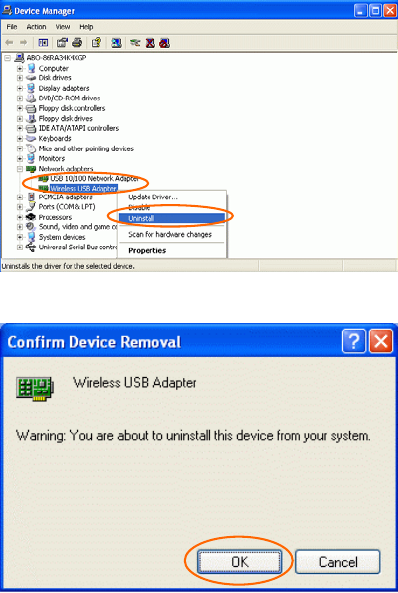
- 59 -
2. In Network Adapter item, right-click USB 10/100 Network
Adapter and then select Uninstall.
3. Click OK to uninstall this device.

- 60 -
Specifications
Wireless
Standard IEEE 802.11b
Host Interface USB 1.1
Physical Weight: 450 g
Dimension: 91.5(L) x 64 (W) x 24.2(H) mm
Antenna External Antenna, rotating angle 0° to 90°
LED Indicators
Ethernet: Green, ON
Power: Green, ON
WLAN: Green, ON
Power Requirement
Operating Voltage: 5V DC
TX consumption: 442mA (Max)
RX consumption: 261mA (Max)
Frequency Range 2.412GHz ~ 2.4835GHz
Number of
Selectable Channels
USA, Canada: 11 channels
Europe: 13 channels
Japan: 14 channels
Modulation
Technique
Direct Sequence Spread Spectrum (CCK, DQPSK,
DBPSK)
Security 0/64/128 bit WEP
Spreading 11 chip Barker sequence
Bit Error rate Better than 10-5

- 61 -
Media Access
Protocol CSMA/CA (Collision Avoidance) with ACK
Supported OS Windows 98SE/ ME/ 2000/ XP
EMC Certification FCC Part 15 in US
EN300328 and EN300826 (301489-17) in Europe
LAN
Standards IEEE 802.3 for 10BaseT Ethernet
IEEE 802.3u for 100BaseT Ethernet
Ports 1 RJ-45 port; 1 USB B type port
Data Rate 10/100 Mbps for Ethernet data transfer
Supported OS Windows 98SE/ ME/ 2000/ XP